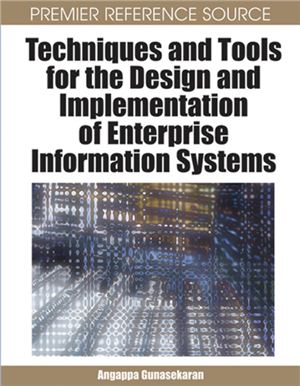Издательство IGI Global, 2008, -408 pp.
Enterprise resource planning (ERP) system is an enterprise-wide information system. ERP systems automate business processes and provide access to data from global operations. These systems have been used to integrate business processes along the supply chain. It is hard to imagine a well-integrated supply chain without the application of ERP. Techniques and tools play a major role in the design, development and implementation of enterprise information systems (EIS). In the past, many companies have reported failures with reference to the implementation of ERP systems. Most companies had problems with the design and implementation of ERP due to lack of adequate techniques and tools to design and implement the EIS. Considering the importance of ERP in global enterprise environments, and the competitiveness of companies in global markets, this edited book focuses on the techniques and tools for the design, development and implementation of EIS.
Effective communication along the supply chain is essential to provide high-level customer service by delivering the right products, at the right time and in the right quantity and price. In order to avoid any quality and delivery problems of materials, a real-time and shared information system such as ERP is important. The objective of EIS is to facilitate a smooth flow of information along the supply chain. Many companies have failed in their attempt to successfully implement ERP due to lack of proper planning and having the right techniques and tools for the design and implementation of EIS. Implementation of ERP starts with whether a company needs such a system and then selecting the right system considering the nature of its business and the overall scope of the market. Hence, there is a need to carefully align the business model with information model or system. For this, companies need suitable techniques and tools for the development and implementation of ERP systems. This edited book presents some useful strategies, techniques and tools for the design, development and implementation of EIS. It is our hope that both academic researchers and practitioners will benefit from the strategies, techniques and tools presented for the design and implementation of EIS. An overview of the chapters is presented hereunder.
Applying Collaboration Theory for Improving ERP System-User Interaction
A Component-Based Tool Architecture for Performance Modeling and Optimization
The Critical Success Factors across ERP Implementation Processes
Integrated Design System: An Information Processing Approach for Knowledge-Based Product Development
Behavioral Aspects in Strategic Transformation of Organizations
Decisional DNA and the Smart Knowledge Management System: A Process of Transforming Information into Knowledge
Organizational Readiness to Adopt ERP: An Evaluation Model for Manufacturing SMEs
Design and Development of ISO 9001:2000 — Based Quality Management Information System
Motivational Aspects of Legitimate Inteet File Sharing and Piracy
Management (CRM) Metrics
Development of Intelligent Equipment Diagnosis and Maintenance System using JESS: Java Expert System Shell Technology
Measuring of Web Performance as Perceived by End-Users
Information System Development: Using Business Process Simulation as a Requirements Engineering Tool
Selfish Users and Distributed MAC Protocols in Wireless Local Area Networks
Enterprise resource planning (ERP) system is an enterprise-wide information system. ERP systems automate business processes and provide access to data from global operations. These systems have been used to integrate business processes along the supply chain. It is hard to imagine a well-integrated supply chain without the application of ERP. Techniques and tools play a major role in the design, development and implementation of enterprise information systems (EIS). In the past, many companies have reported failures with reference to the implementation of ERP systems. Most companies had problems with the design and implementation of ERP due to lack of adequate techniques and tools to design and implement the EIS. Considering the importance of ERP in global enterprise environments, and the competitiveness of companies in global markets, this edited book focuses on the techniques and tools for the design, development and implementation of EIS.
Effective communication along the supply chain is essential to provide high-level customer service by delivering the right products, at the right time and in the right quantity and price. In order to avoid any quality and delivery problems of materials, a real-time and shared information system such as ERP is important. The objective of EIS is to facilitate a smooth flow of information along the supply chain. Many companies have failed in their attempt to successfully implement ERP due to lack of proper planning and having the right techniques and tools for the design and implementation of EIS. Implementation of ERP starts with whether a company needs such a system and then selecting the right system considering the nature of its business and the overall scope of the market. Hence, there is a need to carefully align the business model with information model or system. For this, companies need suitable techniques and tools for the development and implementation of ERP systems. This edited book presents some useful strategies, techniques and tools for the design, development and implementation of EIS. It is our hope that both academic researchers and practitioners will benefit from the strategies, techniques and tools presented for the design and implementation of EIS. An overview of the chapters is presented hereunder.
Applying Collaboration Theory for Improving ERP System-User Interaction
A Component-Based Tool Architecture for Performance Modeling and Optimization
The Critical Success Factors across ERP Implementation Processes
Integrated Design System: An Information Processing Approach for Knowledge-Based Product Development
Behavioral Aspects in Strategic Transformation of Organizations
Decisional DNA and the Smart Knowledge Management System: A Process of Transforming Information into Knowledge
Organizational Readiness to Adopt ERP: An Evaluation Model for Manufacturing SMEs
Design and Development of ISO 9001:2000 — Based Quality Management Information System
Motivational Aspects of Legitimate Inteet File Sharing and Piracy
Management (CRM) Metrics
Development of Intelligent Equipment Diagnosis and Maintenance System using JESS: Java Expert System Shell Technology
Measuring of Web Performance as Perceived by End-Users
Information System Development: Using Business Process Simulation as a Requirements Engineering Tool
Selfish Users and Distributed MAC Protocols in Wireless Local Area Networks

